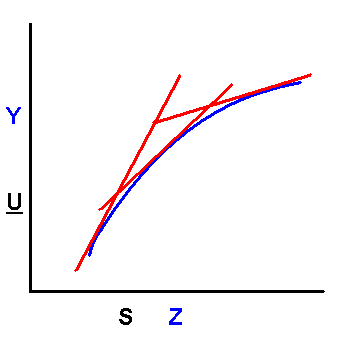The Fundamental Equation:
![]()
Where:

and:
![]()
or:



These are the starting point for EOS:
Now take the derivative of the above with respect to other independent variables:



If we differentiate w.r.t: S,etc. we get:



There are similar arguments for D H, D G, D A, electromagnetism, gravity, etc.:
Eg: --- Given:
![]()
and:

etc!
What other relationships do we have to work from?
If we recognize that each property such as P, T, V, etc. can be used in our n + 2 postulate. It can be shown via "
Legendre Trasformations" that a derivative can replace these values in our description:
These lead to the rest of the thermodynamic identities and a few definitions:
There are 3 Legendre transforms of the fundamental equation:
![]()
2 first order transforms:
(one variable changed)![]()
![]()
1 second order transform:
![]()
Or in differential form:
![]()
![]()
![]()
![]()
Now we have the ability to define the remainder of our identities:
Eg:

From previous page: =T =V
To summarize:





etc.
One final transform:
![]()
![]()
or
![]()
Additional useful relationships:
Recall that previously we defined:


dividing expression
2) by dT and evaluating at constant P yields:
If we divide
2) by dP, evaluate at Const. T: etc.
Other similarly derived physical constants include :


since:

We can se our definitions:

and from:

![]()
Replace b into equation
5):![]()